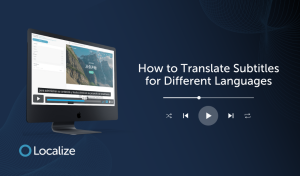Of the 5 billion internet users scattered all over the world, about 90% of us watch videos every single week. So it’s no surprise that video is one of the most effective online marketing tools.
If you limit your video’s audience to English speakers only, you might be missing out on big opportunities, like more leads and higher ROI. Just like any other visual content, marketing videos need to be localized for different audiences around the world.
Join us as we explore the basics of video translation and localization.
What is Video Localization?
Video localization is the process of editing a video to make it more accessible to a new audience in a specific locale. A very simple example of video localization is dubbing a video in multiple languages to reach viewers with different linguistic backgrounds.

Aside from dubbing, other methods of video localization include lip-syncing and adding subtitles. But there’s a lot more to video localization than just adding a translation.
Benefits of Video Localization
Localizing videos is an investment, but does it pay off?
Here’s what our research shows:
- Localized Videos Reach a Wider Audience
Adapting your videos for international viewers brings your content to a much bigger audience. Think about YouTube, for example. Billions of people worldwide log in to YouTube every month, and each day users watch a billion-plus hours of video. A big percentage of these video watchers reside outside the U.S. This means a lot of global consumers are spending time browsing available videos for products, music, and almost anything else you could imagine. - Search Engines Love Translated Videos
Many search engines like Google strongly favor localized videos. They’ll reward localized videos with higher rankings on search results pages. This leads to better SEO and easier discoverability for you and your brand. - Video Localization Contributes to Great UX
According to researchers, most people prefer to watch videos with the sound off–especially if they’re in public spaces. Localized videos with subtitles are proven to increase the average watch time. This leads to more engagement and a better overall user experience. - Videos Bring More ROI than Other Content
When compared to other marketing methods, studies show that videos produce 66% more qualified leads per year and a 54% increase in brand awareness. In a survey from Animoto, 80% of marketers were satisfied with the ROI of videos shared on social.
3 Methods for Video Translation
If you have marketing videos such as product demos that you would like to localize, the first step is to become familiar with the vocabulary of video translation and localization. The basic concept to understand is that the visual aspect of the video doesn’t change as long as it doesn’t contain anything that clashes with the local culture. It’s the audio that gets localized. Here’s a handy list of basic global video localization terminology to get you started.
1: Subtitling
If you are working on a tight budget, subtitles are a cost-effective way to reach new global audiences. The original English script gets transcribed into easily readable subtitles. There are a couple of ways of doing this.
- Translated Subtitles
The original script of the English video is translated and then shortened, if necessary. The translated subtitles are displayed at the bottom of each screen. They are time-coded so that each subtitle matches what is taking place on the screen. With this option, the user cannot turn off the subtitles.
- Closed Captioning
The subtitles are hidden until the viewer selects them. Closed captioning can include non-speech components like sounds or music. The user can choose to turn the subtitles on or off.
2: Audio Voiceover Recording
The translated script is recorded using a person with an authentic native voice and then integrated back into the video. You have several options for audio voiceover recording depending on your budget and the way you want the video to work:
- Dubbing
This is the most widely used option. The original English in the video is replaced by a speaker’s voice in the target language. This method means that the speaker’s voice can’t match up with the lip movements of the English speaker. However, the voiceover is time-coded so that the speaker begins and ends at the same point as the original speaker.
- Lip Synching
This is a method for matching lip movements. It is similar to dubbing, but the words are lip-synched to the original speaker’s mouth movements. Lip synchronization is very complex and time-consuming and, therefore, expensive.
- UN Style Voiceover
This method involves turning down the volume when English is being spoken and replacing it with the target language at a much higher volume. With this style of voiceover, the original speaker can still be heard in the background, making it clear that the voiceover is a translation of what is being said. This method is commonly used for interviews, meetings, presentations, and TV programs.
3: Audio Voiceovers and Subtitles
You can opt for a combination of both voiceovers and subtitles. Combining voiceovers and subtitles is especially applicable for videos where it’s useful for people to be able to see and hear at the same time. It’s also suitable for the hearing impaired.
How to Begin Video Localization
Need some help getting started? These tips will help you know where to start in your video localization journey.
Getting Started
- Plan your content:
If you have decided at the start of making the video that you want to add subtitles or have it dubbed, first make sure that the content is a great fit for a wider global audience. - Visuals:
When adding subtitles, avoid having any important content in the bottom section of the screen. - Translation:
No one enjoys a botched translation! Be sure to hire a reliable translator or language service provider (LSP) for your video localization project. - Cultural aspects:
What may appear as normal or harmless content in one culture might be accepted differently by other cultures. Be informed of local cultures and sensibilities before releasing any content in a new area. - Budget:
If you’re on a budget, your best bet for video localization is subtitling. This is a quick and cost-effective way to distribute content in different languages. - Research your target audience:
Knowing your target audience is key in developing content that works. Not all content is for everyone. Understanding the target audience in each locality will help you create better content. - Your channel:
When posting content on sites like YouTube, you can have one channel with multiple languages or a separate channel for each localized language. - Marketing:
The main purpose of a marketing video is to increase your customer base. Make sure to end content with a good CTA that will help you generate international leads.
Best Practices
Listed below are a few basic tips to keep in mind during video localization:
- The video’s subject matter should have a global appeal.
If your theme resonates universally, then you’re on the right track for a compelling international video.
- Make room for text expansion in subtitles.
When translating English into different languages, text length may be longer or shorter than the original English text. Be sure that your video has enough room for subtitles in lengthier languages like German.
- Don’t forget about hyperlinks.
Hyperlinks should be localized, and they should be as evergreen as possible. Universality is key.
- Localize only the finished product.
Any changes made to a work-in-progress be costly due to revision and duplication of efforts.
- Properly pace your video scripts.
When recording, you should make short pauses between statements. The usage of properly-timed audio scripts is the best way to support modifications during post-processing.
- Adopt the right fonts for translated subtitles, animations, and graphics.
Ensure that all fonts used to localize your video content are familiar to the end-users.
- Use loop-supported music.
Make sure the style of music added as a backdrop to your videos is capable of supporting localized expansion. Perfect synchronization between audio and video needs to be established during the storyboarding phase.
- Keep the lower area of the screen empty.
Employ proper camera angles to capture your video, leaving adequate space to add subtitles for localization later on.
- Remember to include metadata.
Always remember to include metadata (like tags, hyperlinks, descriptions, and titles) when uploading to popular video-sharing platforms. This will improve your SEO and help you reach a wider audience.
Why Choose Localize?
Localize can help you translate and localize your digital content into your target audience’s language. Our TMS provides top-quality translation and localization services in one streamlined dashboard. We’ll help you subtitle your videos, translate sites, and transform apps for international audiences.
Contact us today for more information.







